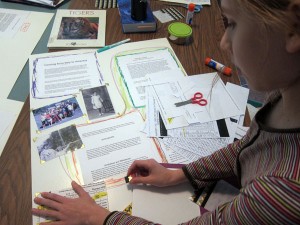 Our approach to assessment is focused on evaluating students’ learning, growth, and progress in meaningful, useful, and authentic ways. Individual student goal-setting and self-evaluation reflect our emphasis on student self-direction. These are used in combination with portfolios and teachers’ narrative assessments to create a picture of each student’s growth in key skill and content areas as well as progress towards personal, intellectual, and creative goals. Because Pacem’s classes are small, teachers are able to observe and document student progress during daily class activities. Teachers also evaluate student work (written work, projects, oral presentations, etc.) and may use performance-based assessments, skills checklists, and/or rubrics. These inform the teachers’ narrative assessments and/or are included in portfolios to reflect student progress and areas for future growth.
Our approach to assessment is focused on evaluating students’ learning, growth, and progress in meaningful, useful, and authentic ways. Individual student goal-setting and self-evaluation reflect our emphasis on student self-direction. These are used in combination with portfolios and teachers’ narrative assessments to create a picture of each student’s growth in key skill and content areas as well as progress towards personal, intellectual, and creative goals. Because Pacem’s classes are small, teachers are able to observe and document student progress during daily class activities. Teachers also evaluate student work (written work, projects, oral presentations, etc.) and may use performance-based assessments, skills checklists, and/or rubrics. These inform the teachers’ narrative assessments and/or are included in portfolios to reflect student progress and areas for future growth.
Narrative Assessments:
Twice a year, teachers write a narrative assessment of each student in their classes. The goal of the assessments is to document and communicate the concepts and skills that the student has mastered and to outline areas in which the student would benefit from more focused study. The assessments will reference learning goals that have been set out by students and teachers at the beginning of a class. Narrative assessments are part of a student’s academic record at Pacem.
Student portfolios:
One of the most important assessment tools at Pacem is each student’s ongoing portfolio. Each year students will select pieces of work that they feel best represent their academic accomplishments and write a brief reflection on each chosen piece. This collection reflects their growth in key skill areas and their progress towards personal, intellectual and creative goals. The portfolio also guides each student’s self-assessment and self-knowledge or meta cognition.

